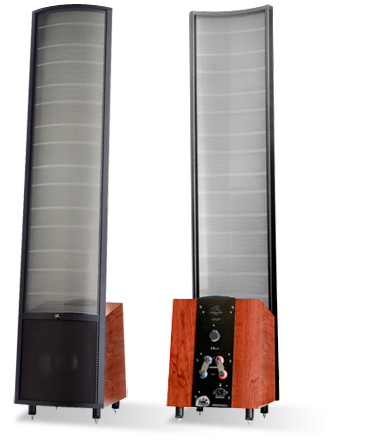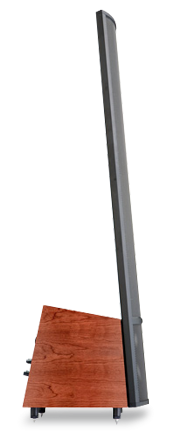
 There's more than one way to design a good loudspeaker, and no one type of speaker is inherently superior to the rest -- each has its own strengths and weaknesses. Though I generally prefer the sound of dynamic, direct-radiating speakers, I've heard some excellent-sounding bipolar and omnipolar designs, and have thoroughly enjoyed some dipolar planar speakers.
There's more than one way to design a good loudspeaker, and no one type of speaker is inherently superior to the rest -- each has its own strengths and weaknesses. Though I generally prefer the sound of dynamic, direct-radiating speakers, I've heard some excellent-sounding bipolar and omnipolar designs, and have thoroughly enjoyed some dipolar planar speakers.
The speakers made by MartinLogan, Ltd. are different from most. For over two decades now, they've designed and made electrostatic loudspeakers, most of them hybrid designs in which a conventional woofer is coupled with an electrostatic panel. While I'd never had a pair of MartinLogans in my system, I'd long admired their hallmark open sound, which is not quite like anything I've heard from a conventional dynamic speaker. Offered the chance to review a MartinLogan speaker, I welcomed it.
Hybridization
The Spire sits near the top of MartinLogan's product line, and stands tall at 59"H x 12.5"W x 17.75"D. Although that might seem quite tall, most of the speaker's height is taken up by its curved, electrostatic high-frequency transducer, which is 44"H but only an inch or two deep. The electrostatic panel sits atop the enclosure for the powered woofer, which is only about 15" high. Because its panel is narrow and mostly transparent, the Spire doesn't visually dominate a room as might a dynamic speaker of the same size; I thought it looked quite modern, even graceful. The Spire costs $8495/pair in standard finishes; custom finishes are available at additional cost. My samples were finished in high-quality dark cherry for the woofer enclosure and black for the aluminum components of the electrostatic panel.
That electrostatic panel is the heart of the Spire. It comprises a thin, plasma-deposited diaphragm of polyethylene terathylate (PET), sandwiched between two MicroPerf stators. Basically, an electrostatic panel produces sound when the positively charged diaphragm is pushed and pulled by the front and back stators, which have charges of opposite but equal strength. MartinLogan claims that the individual holes in their MicroPerf panels are smaller than those in conventional electrostatics, and that there are more of them, enough to double the diaphragm's effective radiating area without compromising its structural integrity.
ML's Curved Linear Source (CLS) technology results in a gently curved panel designed to enhance the dispersion of high frequencies from so large a radiating surface. The panel is framed by and secured to the cabinet with what ML calls an AirFrame. This is made of extruded aerospace-grade aluminum composite and is claimed to be extremely rigid, to provide acoustical isolation and reduce vibration and resonance. Overall, the Spire seems to be well designed and solidly built, with a high level of fit and finish.
The sealed woofer enclosure houses a forward-firing, 10" aluminum-cone driver powered by a 200W amplifier and a proprietary Vojtko crossover derived from MartinLogan's flagship CLX speaker. At the rear of the cabinet is an IEC inlet for the provided power cord. Four large binding posts unique to MartinLogan are provided for biwiring, if desired, and a 35Hz level control is provided to adjust the speaker's output at this frequency, which is often affected by room interactions. There's also an On/Dim/Off switch for the illuminated MartinLogan logo at the top of the enclosure.
Setup
The Spires were easier to position than I'd expected dipolar speakers to be. With a width of only 12', my room is relatively narrow; the Spires ended up roughly 3' from the sidewalls and the same distance from the front wall. I found that placing them a little closer together and toeing them in more than I would a pair of conventional speakers gave me excellent, stable imaging, even with my 56" RPTV sitting between and slightly behind the speakers. I found that the Spires sounded best with their 35Hz level controls set at 0dB.
Performance
 The Spire was as appealing sonically as it was visually, with a fast, transparent sound that was immediately involving. The bass, too, was very good, especially considering that it came from a 10" driver in a relatively small, sealed enclosure. I'd thought the speaker might have some difficulty in integrating its potent bass with the agile upper frequencies of the electrostatic panel, but quickly realized that this was not the case. The Spire sounded quite smooth from top to bottom, with an exceptionally transparent midrange, and high frequencies that let it unravel the nuances of even the most complex recordings. And while the Spire certainly had a lot of immediate "wow" factor, extended listening revealed no significant deficiencies. I found it just as thrilling and satisfying after weeks of long listening sessions as it was in the first few hours.
The Spire was as appealing sonically as it was visually, with a fast, transparent sound that was immediately involving. The bass, too, was very good, especially considering that it came from a 10" driver in a relatively small, sealed enclosure. I'd thought the speaker might have some difficulty in integrating its potent bass with the agile upper frequencies of the electrostatic panel, but quickly realized that this was not the case. The Spire sounded quite smooth from top to bottom, with an exceptionally transparent midrange, and high frequencies that let it unravel the nuances of even the most complex recordings. And while the Spire certainly had a lot of immediate "wow" factor, extended listening revealed no significant deficiencies. I found it just as thrilling and satisfying after weeks of long listening sessions as it was in the first few hours.
I did some of my listening in the weeks leading up to Christmas, and the Spires' brilliant, transparent sound with seasonal music really got me into the holiday spirit. The MLs' speed and neutrality, combined with their uncanny ability to produce a holographic soundstage, gave me a new appreciation of Holly Cole's wonderfully recorded Baby, It's Cold Outside (CD, Alert 6152810382). In the title track, her playful singing was placed precisely in the soundstage, along with that of the Barenaked Ladies' lead singer, Ed Robertson. Robertson's voice seemed to emanate from just left of center and relatively low in the soundstage; Cole's was from farther back, and slightly above and to the right. These images were so cleanly and crisply presented that it reminded me of a cold, clear winter's day and gave me goose bumps. In "Sleigh Ride," David Piltch's double bass -- the only instrument played in this track -- emerged from a pitch-black background. The attack and decay of each plucked note, and the resonance of the instrument's body -- which Piltch also occasionally slaps and knocks -- were astonishing in their clarity. The Spires expertly reproduced Cole's voice as it ranged from a mere whisper to powerful climaxes, as well as her slight slurring of some words.
Keeping with the holiday spirit, I then listened to a high-resolution download of Diana Krall's Christmas Songs (24/96 FLAC, Verve/HDtracks). The arrangements are uninspired, but Krall's voice has been captured with striking realism. I often describe well-recorded voices as sounding "palpable" or "immediate," but with the MartinLogan Spires the experience was remarkable. Krall sounded smoky and sultry, with just the right hint of sibilance -- I could hear the air moving past her lips as she articulated each word. The noise floor was virtually nonexistent; it seemed as if my listening room had been transformed into a recording studio, with Krall standing between the two speakers.
I'm growing weary of Lady Gaga's "Poker Face," from The Fame Monster (CD, Streamline/Interscope 0602527210360), but this densely layered dance track provided an excellent test of the Spire's dynamic range, speed, and transparency, all of which clearly shone through. Each of Gaga's multiple vocal overdubs was easily distinguishable, and the synthesizers and steady drum beats were spread throughout the soundstage. The bass in "Love Game" was deep and satisfying, and the soundstage was even more expansive, extending well outside the speakers. Not only was that stage incredibly wide, it also had great depth, and spread the music coherently from left to right. The result: a very large soundstage with incredibly well-defined, holographic images.
The Spires moved easily from synthesizer-infused dance tracks to audiophile-approved recordings without missing a beat. The gloriously natural sound of violinist Marianne Thorsen and the Trondheimsolistene in a disc of Mozart's Violin Concertos (24/96 FLAC, 2L/HDtracks) was reproduced beautifully by the Spires, as was Neil Young's growling electric guitar in Le Noise (CD, Reprise 093624961864). Whether played at high or relatively low volumes, the Spires always presented a balanced sound with deep bass and transparent mids and highs, and sounded excellent with all types of music.
A common goal
My usual reference speaker, Paradigm's Reference Signature S6 v.3, costs $5798/pair. It's an exceptional speaker for the price, but in some areas it couldn't match the MartinLogan Spire. Most notably, the Paradigms couldn't re-create the sense of space produced by the MLs. While the Paradigms threw up a large soundstage, it was slightly smaller, in all dimensions, than the one created by the Spires. The latter were better able to re-create the sense of a recording venue -- in the hi-rez download of Ry Cooder and V.M. Bhatt's A Meeting by the River (24/88.2 FLAC, Water Lily Acoustics/HDtracks), the reverberation of the tabla and dumbek seemed to travel farther back into the sanctuary of Christ the King Chapel of St. Anthony's Seminary, in Santa Barbara, California. This pure stereo recording, made with a Blumlein microphone arrangement, has a large, natural sense of space. The Paradigms, while never sounding closed-in, made the chapel sound a little smaller.
The Spires also let me hear deeper into recordings, and made images within a soundstage more distinct by precisely defining the spaces between them. Whether it was simple recordings (A Meeting by the River) or complexly mixed tracks (The Fame Monster), the layering within recordings was more discrete, and soundstages extended farther in all dimensions. Not only was the Spires' soundstage bigger with "Keith Don't Go," from Nils Lofgren's Acoustic Live (CD, Vision 820761101422), so was the size of the guitar's image within that stage. Individual guitar strings emerged from different locations that, through the Spires, seemed farther apart. The more precisely defined spaces between the crystalline images further enhanced the sense of space between the strings and the apparent size of the guitar. Through the Paradigms, the less focused sound of the strings resulted in a slightly more homogenous depiction of the guitar. The Spires' magnificently open and transparent sound was something that I have never experienced with a dynamic speaker at anywhere near its price range.
The Spires may have been able to project a huge, transparent, holographic soundstage, but the Paradigms bested them in the bass. Though the Spires actually seemed to go a bit lower than the Reference Signature S6 v.3s, the Paradigms exerted superior control over the low frequencies. With "Starstruck," from Lady Gaga's The Fame Monster, the pulsing bass was so tight and controlled that it seemed as if the Paradigms' woofer cones were directly coupled to the amplifier, and the bass still went surprisingly deep for such relatively small speakers. This gave the music fantastic rhythm and pace. The Spires' powered woofers fully reproduced these low frequencies, but with not as much control as the Paradigms. This robbed the music of some of its pace, and made me feel less like getting up and dancing or moving my body to the music with dance tracks by Lady Gaga or other artists.
A common concern about hybrid designs is the quality of integration between the electrostatic and dynamic drivers -- but I heard no such problem in the Spire. The ML did lack a touch of weight in the upper bass, but given its overarching clear and open sound, this was barely noticeable, and apparent only when I compared it directly to the Paradigm S6 v.3's ultrasmooth response from top to bottom.
In the end, I enjoyed listening to the MartinLogan Spires as much as I did my reference, Paradigm's Reference Signature S6 v.3s. Although each had its respective strengths, each was also an excellent performer that I could happily live with in my reference system.
Conclusion
MartinLogan's Spire is a visually stunning loudspeaker with a big, open sound to match. It did not, however, sound exaggerated or over the top in any way, and had few sonic compromises. If you think a hybrid electrostatic loudspeaker isn't for you, give the Spire a listen. In fact, anyone considering spending around $8495 for a pair of speakers should hear just how great the Spire actually is.
. . . Roger Kanno
rogerk@soundstagenetwork.com
Associated Equipment
- Preamplifier/DAC -- Bel Canto DAC2.5
- Amplifier -- Bel Canto e.One REF1000
- Sources -- Oppo BDP-83 universal Blu-ray player, Asus Aspire 5290 laptop computer running foobar2000
- Cables -- Analysis Plus Solo Crystal Oval interconnect and Black Oval 9 speaker, DH Labs Silver Sonic DV-75 digital
- Power cords -- Essential Sound Products AVP-16
- Power conditioners -- Blue Circle Audio Peed Al Sea Thingee, Zero Surge 1MOD15WI
MartinLogan Spire Loudspeakers
Price: $8495 USD per pair.
Warranty: Five years parts and labor.
MartinLogan, Ltd.
2101 Delaware St.
Lawrence, KS 66046
Phone: (785) 749-0133
Fax: (785) 749-5320
E-mail: info@martinlogan.com
Website: www.martinlogan.com






















